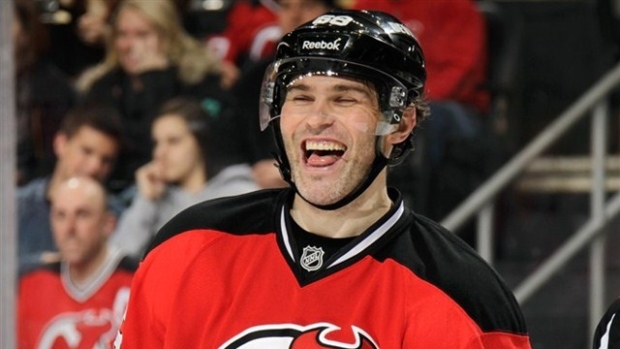Nov 4, 2014
Yost: An appreciation for the graceful aging of Jaromir Jagr
Jaromir Jagr is going to retire as one of hockey’s most accomplished talents. He has won NHL scoring title five times, earned MVP honors once, named to seven first or second all-star teams and two Stanley Cups plus an Olympic gold in 1998. Travis Yost has some other reasons to be amazed by this generational talent.
By Travis Yost

Jaromir Jagr is going to retire as one of hockey’s most accomplished talents. He has won NHL scoring title five times, earned MVP honors once, named to seven first or second all-star teams and two Stanley Cups plus an Olympic gold in 1998.
It’s an astonishing collection of hardware – one that’s long made him a first-ballot Hall of Famer. And yet, I’m not sure any of this captures the uniqueness of this generational talent.
Maybe the most amazing aspect of Jaromir Jagr, now 42, is that there hasn’t been a quick and fast depreciation in his skill set. It’s a fascinating phenomenon, because there’s plenty of data to suggest that the aging process is a cruel one for players, generally as they hit that 30-and-beyond mark.
In Jagr’s case, the 30-year mark was twelve years ago, and there are a ton of miles on his body. Jag has played 1,686 games spanning the Czech League, NHL and KHL (2008-11) since 1988. One could reasonably estimate that such a burden on a player – even one of Jagr’s talent – would be onerous.
A close examination of Jagr’s key 5-on-5 numbers since age 34 in the NHL are revealing. His 5-on-5 icetime, by the way, has remained relatively consistent; it was 13:26 per game in 2006-07 and is 13:38 per game this season.
Jagr's Relative Dominance
| Season | PTS/60 | Corsi On% | Corsi Off% |
|---|---|---|---|
| 2006-07 | 2.79 | 55.1% | 47.6% |
| 2007-08 | 1.86 | 59.1% | 51.5% |
| 2011-12 | 1.97 | 53.5% | 49.9% |
| 2012-13 | 2.04 | 53.1% | 50.0% |
| 2013-14 | 2.00 | 59.2% | 52.3% |
| 2014-15 | 1.20 | 60.0% | 48.0% |
Jagr’s scoring rate has experienced a drop this season, but with only 11 games played, it’s probable this is statistical noise. Scoring in and of itself is a volatile thing in hockey, and based on his output in recent seasons, it’s reasonable to believe he’ll jump back near his usual 2-points-per-60 rate.
The impressive data comes in the two right columns. Here, we have Corsi% On, which shows the percentage of a team’s 5-on-5 shot attempts with the player on the ice. Corsi% Off shows the opposite – the percentage of a team’s 5-on-5 shot attempts with player the off the ice. The statistical theory is that, if a player is having a positive impact on his team’s performance, the team will benefit with him on the ice, and suffer with him off the ice.
For basically every season in which we have the data, Jagr’s teams have been significantly better with him on the ice. Most outrageous is the fact that in the early goings of the 2014-2015 season, New Jersey is controlling 60.0% of play 5-on-5 with Jagr on the ice – a number reserved only for the league’s elite. New Jersey is controlling just 48.0% of play at 5-on-5 when Jagr is on the bench. It’s difficult to believe that New Jersey could very well be reliant on the performance of a 42-year-old to push towards the post-season, but based on the early numbers, it appears to be the case. The team is fantastic with him, and not so much without him.
Let’s return to Jagr’s multi-year performance – specifically his Corsi% On and Corsi% Off numbers. Jagr has played 375 games in the NHL since 2006-07.
Just how great has Jagr been over these years relative to his peers? We looked at the Corsi performances of every forward who has appeared in at least 375 games and here are the top 10 in terms of Corsi Relative.
Relative Elite
| PLAYER | GP | AGE | CorsiRel% |
|---|---|---|---|
| Daniel Sedin | 593 | 25-34 | +8.3% |
| Henrik Sedin | 621 | 25-34 | +7.0% |
| Justin Williams | 508 | 24-33 | +6.4% |
| Jaromir Jagr | 375 | 33-42 | +6.1% |
| Patrik Elias | 570 | 29-38 | +5.6% |
| Chris Kunitz | 578 | 26-35 | +5.6% |
| Patrice Bergeron | 518 | 20-29 | +5.6% |
| Zach Parise | 546 | 21-30 | +5.5% |
| Corey Perry | 611 | 20-29 | +5.3% |
| Sidney Crosby | 478 | 18-27 | +5.1% |
There’s a couple of notables here. One, only three forwards posted a better RelativeCorsi% (the difference between a player’s Corsi% On and Corsi% Off) than Jaromir Jagr. Two, there’s a key difference between Jaromir Jagr and everyone else – Jagr’s doing it in the twilight of his career, and except for portions of Elias’ run, the rest of these players posted these definitively elite possession numbers in prime years. Considering how many of Jagr’s peers have long aged out of the league due to performance decline and/or injury issues, it’s doubly astonishing.
Jagr’s joked about playing until the age of 50 in interviews with local media, so it’s quite possible we’re going to see a lot more of the Czech beyond the 2014-2015 season. Based on his play so far, that’s a very good thing for the National Hockey League.



